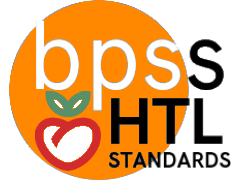BPS District Health Standards Book
Completion requirements
Health Grade Levels
Middle School
Middle School Grade Band
MS Health "I can ... statements"
Standard 1: Growth and Development
HTL-MS.s1 Understand concepts related to human growth and development, health promotion, disease prevention.
- HTL-MS.s1.01: Analyze the relationship between health behaviors and personal health.
- HTL-MS.s1.02: Describe the interrelationships of emotional, mental, emotional, physical, and social health in adolescence.
- HTL-MS.s1.03: Analyze how the environment affects personal health.
- HTL-MS.s1.04: Describe how family history can affect personal health.
- HTL-MS.s1.05: Describe ways to reduce or prevent injuries and other adolescent health problems.
- HTL-MS.s1.06: Explain how appropriate health care can promote personal health.
- HTL-MS.s1.07: Describe the benefits of and barriers to practicing health enhancing behaviors.
- HTL-MS.s1.08: Examine the potential seriousness of injury and illness if engaging in unhealthy behaviors.
- HTL-MS.s1.09: Identify the anatomical structures of the reproductive system.
- HTL-MS.s1.10: Explain the processes of conception, prenatal development, and birth.
- HTL-MS.s1.11: Identify the benefits of abstinence and/or contraceptive methods.
- HTL-MS.s1.12: Acknowledge differences among individuals regarding gender.
HTL-MS.s2 Analyze the influence of family, peers, culture, media, technology, and other factors on health behaviors.
- HTL-MS.s2.01: Analyze how family influences the health of individuals.
- HTL-MS.s2.02: Describe how culture, personal values, and beliefs support and challenge health practices and behaviors
- HTL-MS.s2.03: Describe how peers influence health behaviors.
- HTL-MS.s2.04: Analyze how the school and community can affect personal health practices and behaviors.
- HTL-MS.s2.05: Analyze how messages from media and technology influence health behaviors.
- HTL-MS.s2.06: Explain the influence of norms, personal values, and beliefs on individual health behaviors.
- HTL-MS.s2.07: Describe how some health risk behaviors can influence the likelihood of engaging in other unhealthy behaviors
- HTL-MS.s2.08: Explain how school and public health policies can influence health promotion and disease prevention.
Standard 3: Access Health Information
HTL-MS.s3 Demonstrate the ability to access valid health information, products and services.
- HTL-MS.s3.01: Analyze the validity of health information, products, and services.
- HTL-MS.s3.02: Access valid health information from home, school, and community.
- HTL-MS.s3.03: Access valid and reliable health products and services
- HTL-MS.s3.04: Describe situations that may require professional health services.
Standard 4: Communication Skills
HTL-MS.s4 Demonstrate the ability to use interpersonal communication skills to enhance health and avoid or reduce health risks.
- HTL-MS.s4.01: Demonstrate effective verbal and nonverbal communication skills to enhance health.
- HTL-MS.s4.02: Demonstrate refusal and negotiation skills to avoid or reduce health risks.
- HTL-MS.s4.03: Demonstrate negotiation skills to avoid or reduce health risks.
- HTL-MS.s4.04: Demonstrate collaboration skills to avoid or reduce health risks.
- HTL-MS.s4.05: Demonstrate effective conflict management or resolution strategies.
- HTL-MS.s4.06: Demonstrate how to ask for assistance to enhance the health of self and others.
HTL-MS.s5 Demonstrate the ability to use decision making skills to enhance health and avoid or reduce health risks.
- HTL-MS.s5.01: Identify circumstances that can help or hinder healthy decision making.
- HTL-MS.s5.02: Apply the decision-making process in health-related situations.
- HTL-MS.s5.03: Distinguish when individual or collaborative decision making is appropriate.
- HTL-MS.s5.04: Distinguish between healthy and unhealthy alternatives to healthrelated issues or problems.
- HTL-MS.s5.05: Predict the potential outcomes of healthy and unhealthy decisions on self and others.
- HTL-MS.s5.06: Choose healthy alternatives over unhealthy alternatives when making a decision.
- HTL-MS.s5.07: Analyze the outcomes of a health-related decision.
HTL-MS.s6 Demonstrate the ability to use goal setting skills to enhance health and avoid or reduce risks.
- HTL-MS.s6.01: Assess personal health practices.
- HTL-MS.s6.02: Develop a goal to adopt, maintain, or improve a personal health practice.
- HTL-MS.s6.03: Apply strategies and skills needed to attain a personal health goal.
- HTL-MS.s6.04: Describe how personal health goals can vary with changing abilities, priorities, and responsibilities.
HTL-MS.s7 Demonstrate the ability to practice health-enhancing behaviors and avoid or reduce health risks.
- HTL-MS.s7.01: Explain the importance of assuming responsibility for personal health behaviors.
- HTL-MS.s7.02: Analyze health behaviors that will maintain or improve the health of self and others.
- HTL-MS.s7.03: Demonstrate health behaviors to avoid or reduce health risks to self and others.
HTL-MS.s8 Demonstrate the ability to advocate for personal, family, and community health.
- HTL-MS.s8.01: Construct a health enhancing position on a topic and support it with accurate information.
- HTL-MS.s8.02: Demonstrate how to influence and support others to make positive health choices.
- HTL-MS.s8.03: Work cooperatively to advocate for healthy individuals, families, and schools
- HTL-MS.s8.04: Identify ways in which health messages and communication techniques can be altered for different audiences
- HTL-MS.s8.05: State a health enhancing position on a topic and support it with accurate information.

